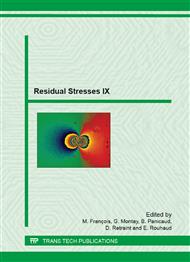p.256
p.262
p.269
p.277
p.283
p.289
p.295
p.301
p.307
Incremental Hole-Drilling Method Vs. Thin Components: A Simple Correction Approach
Abstract:
The incremental hole-drilling method is a widely used technique to determine residual stress depth profiles in technical components. Its application is limited in respect to the components geometry, for instance the components thickness. In this paper, a direct correction of the measured strain relaxations is proposed to consider the impact of deviant geometries, here the component thickness, on the residual stress evaluation that moreover, allows the application of commercially available evaluation software. The herein proposed approach is based on finite element simulation of the incremental hole drilling. The simulated strain relaxations for thin metal sheets are evaluated with an algorithm as used in commercially available evaluation software (i) for uncorrected data as well as (ii) for strain data corrected by the proposed correction procedure. It is shown that the correction approach leads to a significant improvement of the measurement accuracy. Further, by means of the approach residual stress depth profiles in thin metal sheets can be as usual determined using commercial evaluation software for the incremental hole-drilling method regardless of the algorithm used, i.e. differential or integral.
Info:
Periodical:
Pages:
283-288
Citation:
Online since:
August 2014
Authors:
Permissions:
Share:
Citation:


